
Concept explainers
(a)
Interpretation:
It is to be indicated whether the given conversions would be energetically favorable or unfavourable. Also, it is to be given if the reaction is likely to occur readily.
Concept introduction:
Nucleophilic acyl substitution describes a class of substitution reactions involving nucleophiles and acyl compounds. An acid derivative has a leaving group, which is substituted by a nucleophile. If the leaving group is more stable than the nucleophile (weaker in terms of basicity), then the reaction is energetically favorable and occurs readily. If the nucleophile is more stable than the leaving group, then the reaction is enegetically unfavorble and does not occur readilty. This can be explained on the basis of the stability ladder below:
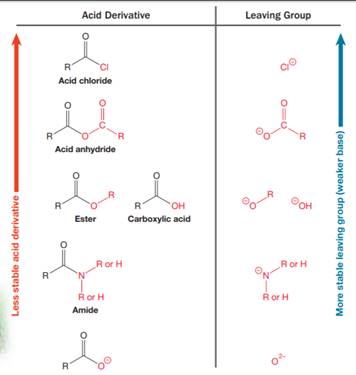
An acyl substitution that converts an acid derivative from a higher rung on the stability ladder to one on a lower rung of the ladder is energetically favorable. An acyl substitution that converts an acid derivative from a lower rung on the stability ladder to one on a higher rung of the ladder is energetically unfavorable.
Answer to Problem 20.5YT
The given conversion would be energetically unfavourable, and the reaction does not occur readily.
Explanation of Solution
The given reaction is

This is an example of a nucleophilic acyl substitution reaction in which an anhydride is getting converted into an acyl chloride. An acid derivative has a leaving group, which is substituted by a nucleophile. If the leaving group is more stable than the nucleophile (weaker in terms of basicity), then the reaction is energetically favorable and occurs readily. If the nucleophile is more stable than the leaving group, then the reaction is enegetically unfavorble and does not occur readilty. This can be explained on the basis of the stability ladder below:
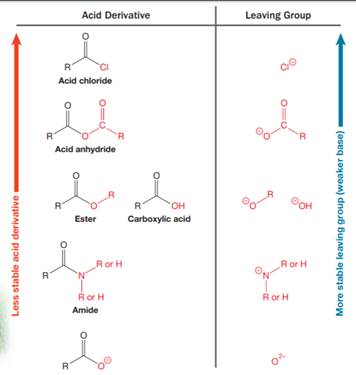
An acyl substitution that converts an acid derivative from a higher rung on the stability ladder to the one on a lower rung of the ladder is energetically favorable. An acyl substitution that converts an acid derivative from a lower rung on the stability ladder to one on a higher rung of the ladder is energetically unfavorable.
Referring to this chart, an acid chloride is from a lower rung while an acyl chloride is from a higher rung on the stability ladder. Thus, this reaction is energetically unfavorable and so does not occur readily.
Conversion of an acid derivative from a lower rung to higher rung on the stability ladder is energetically unfavourable, and the reaction does not occur readily.
(b)
Interpretation:
It is to be indicated whether the given conversions would be energetically favorable or unfavourable. Also, it is to be given if the reaction is likely to occur readily.
Concept introduction:
Nucleophilic acyl substitution describes a class of substitution reactions involving nucleophiles and acyl compounds. An acid derivative has a leaving group, which is substituted by a nucleophile. If the leaving group is more stable than the nucleophile (weaker in terms of basicity), then the reaction is energetically favorable and occurs readily. If the nucleophile is more stable than the leaving group, then the reaction is enegetically unfavorble and does not occur readilty. This can be explained on the basis of the stability ladder below:
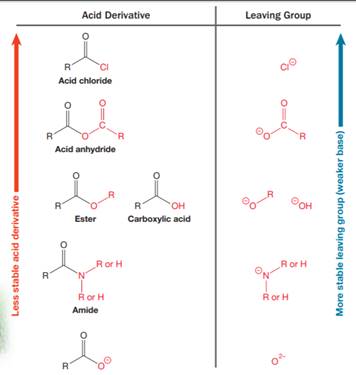
An acyl substitution that converts an acid derivative from a higher rung on the stability ladder to one on a lower rung of the ladder is energetically favorable. An acyl substitution that converts an acid derivative from a lower rung on the stability ladder to one on a higher rung of the ladder is energetically unfavorable.
Answer to Problem 20.5YT
The given conversion would be energetically unfavourable, and it does not occur readily.
Explanation of Solution
The given reaction is

This is an example of a nucleophilic acyl substitution reaction in which an amide is getting converted into an ester. If the leaving group is more stable than the nucleophile (weaker in terms of basicity), then the reaction is energetically favorable and occurs readily. If the nucleophile is more stable than the leaving group, then the reaction is enegetically unfavorble and does not occur readilty. This can be explained on the basis of the stability ladder below:
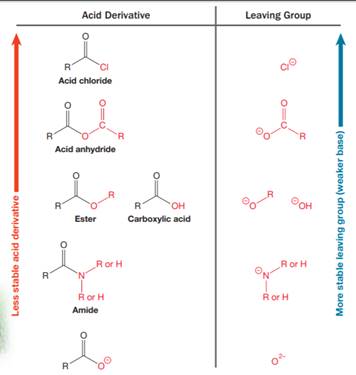
An acyl substitution that converts an acid derivative from a higher rung on the stability ladder to one on a lower rung of the ladder is energetically favorable. An acyl substitution that converts an acid derivative from a lower rung on the stability ladder to one on a higher rung of the ladder is energetically unfavorable.
Referring to this chart, an amide is from a lower rung while an ester is from a higher rung on the stability ladder. Thus, this reaction is energetically unfavorable and so does not occur readily.
Conversion of an acid derivative from a lower rung to higher rung on the stability ladder is energetically unfavourable, and the reaction does not occur readily.
(c)
Interpretation:
It is to be indicated whether the given conversions would be energetically favorable or unfavourable. Also, it is to be given if the reaction is likely to occur readily.
Concept introduction:
Nucleophilic acyl substitution describes a class of substitution reactions involving nucleophiles and acyl compounds. An acid derivative has a leaving group, which is substituted by a nucleophile. If the leaving group is more stable than the nucleophile (weaker in terms of basicity), then the reaction is energetically favorable and occurs readily. If the nucleophile is more stable than the leaving group, then the reaction is enegetically unfavorble and does not occur readilty. This can be explained on the basis of the stability ladder below:
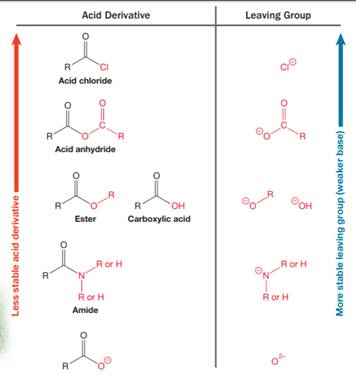
An acyl substitution that converts an acid derivative from a higher rung on the stability ladder to one on a lower rung of the ladder is energetically favorable. An acyl substitution that converts an acid derivative from a lower rung on the stability ladder to one on a higher rung of the ladder is energetically unfavorable.
Answer to Problem 20.5YT
The given conversion would be energetically unfavourable, and it does not occur readily.
Explanation of Solution
The given reaction is

This is an example of nucleophilic acyl substitution reaction in which an acid chloride is getting converted into an ester. If the leaving group is more stable than the nucleophile (weaker in terms of basicity), then the reaction is energetically favorable and occurs readily. If the nucleophile is more stable than the leaving group, then the reaction is enegetically unfavorble and does not occur readilty. This can be explained on the basis of the stability ladder below:
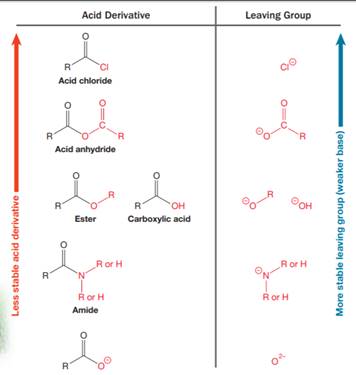
An acyl substitution that converts an acid derivative from a higher rung on the stability ladder to one on a lower rung of the ladder is energetically favorable. An acyl substitution that converts an acid derivative from a lower rung on the stability ladder to one on a higher rung of the ladder is energetically unfavorable.
Referring to this chart, an acid chloride is from a higher rung while an ester is from a lower rung on the stability ladder. Thus, this reaction is energetically favorable and occurs readily.
Conversion of an acid derivative from a higher rung to lower rung on the stability ladder is energetically favourable, and the reaction occurs readily.
(d)
Interpretation:
It is to be indicated whether the given conversions would be energetically favorable or unfavourable. Also, it is to be given if the reaction is likely to occur readily.
Concept introduction:
Nucleophilic acyl substitution describes a class of substitution reactions involving nucleophiles and acyl compounds. An acid derivative has a leaving group, which is substituted by a nucleophile. If the leaving group is more stable than the nucleophile (weaker in terms of basicity), then the reaction is energetically favorable and occurs readily. If the nucleophile is more stable than the leaving group, then the reaction is enegetically unfavorble and does not occur readilty. This can be explained on the basis of the stability ladder below:

An acyl substitution that converts an acid derivative from a higher rung on the stability ladder to one on a lower rung of the ladder is energetically favorable. An acyl substitution that converts an acid derivative from a lower rung on the stability ladder to one on a higher rung of the ladder is energetically unfavorable.
Answer to Problem 20.5YT
The given conversion would be energetically unfavourable, and it does not occur readily.
Explanation of Solution
The given reaction is

This is an example of a nucleophilic acyl substitution reaction in which an acid anhydride is getting converted into dicarboxylic acid. If the leaving group is more stable than the nucleophile (weaker in terms of basicity), then the reaction is energetically favorable and occurs readily. If the nucleophile is more stable than the leaving group, then the reaction is enegetically unfavorble and does not occur readilty. This can be explained on the basis of the stability ladder below:

An acyl substitution that converts an acid derivative from a higher rung on the stability ladder to one on a lower rung of the ladder is energetically favorable. An acyl substitution that converts an acid derivative from a lower rung on the stability ladder to one on a higher rung of the ladder is energetically unfavorable.
Referring to this chart, an acid anhydride is from a higher rung while a
Conversion of an acid derivative from a higher rung to lower rung on the stability ladder is energetically favourable, and the reaction occurs readily.
Want to see more full solutions like this?
Chapter 20 Solutions
EBK GET READY FOR ORGANIC CHEMISTRY
- 6. The equilibrium constant for the reaction 2 HBr (g) → H2(g) + Br2(g) Can be expressed by the empirical formula 11790 K In K-6.375 + 0.6415 In(T K-¹) - T Use this formula to determine A,H as a function of temperature. Calculate A,-H at 25 °C and at 100 °C.arrow_forward3. Nitrosyl chloride, NOCI, decomposes according to 2 NOCI (g) → 2 NO(g) + Cl2(g) Assuming that we start with no moles of NOCl (g) and no NO(g) or Cl2(g), derive an expression for Kp in terms of the equilibrium value of the extent of reaction, Seq, and the pressure, P. Given that K₂ = 2.00 × 10-4, calculate Seq/ of 29/no when P = 0.080 bar. What is the new value по ƒª/ at equilibrium when P = 0.160 bar? Is this result in accord with Le Châtelier's Principle?arrow_forwardConsider the following chemical equilibrium: 2SO2(g) + O2(g) = 2SO3(g) • Write the equilibrium constant expression for this reaction. Now compare it to the equilibrium constant expression for the related reaction: • . 1 SO2(g) + O2(g) = SO3(g) 2 How do these two equilibrium expressions differ? What important principle about the dependence of equilibrium constants on the stoichiometry of a reaction can you learn from this comparison?arrow_forward
- Given Kp for 2 reactions. Find the Kp for the following reaction: BrCl(g)+ 1/2 I2(g) ->IBr(g) + 1/2 Cl2(g)arrow_forwardFor a certain gas-phase reaction at constant pressure, the equilibrium constant Kp is observed to double when the temperature increases from 300 K to 400 K. Calculate the enthalpy change of the reaction, Ah, using this information.arrow_forwardHydrogen bonding in water plays a key role in its physical properties. Assume that the energy required to break a hydrogen bond is approximately 8 kJ/mol. Consider a simplified two-state model where a "formed" hydrogen bond is in the ground state and a "broken" bond is in the excited state. Using this model: • Calculate the fraction of broken hydrogen bonds at T = 300 K, and also at T = 273 K and T = 373 K. • At what temperature would approximately 50% of the hydrogen bonds be broken? • What does your result imply about the accuracy or limitations of the two-state model in describing hydrogen bonding in water? Finally, applying your understanding: • Would you expect it to be easier or harder to vaporize water at higher temperatures? Why? If you were to hang wet laundry outside, would it dry more quickly on a warm summer day or on a cold winter day, assuming humidity is constant?arrow_forward
- (3 pts) Use the Kapustinskii equation to calculate the lattice enthalpy for MgBr2 anddiscuss any differences between this result and that from #4.arrow_forward(3 pts) Silver metal adopts a fcc unit cell structure and has an atomic radius of 144 pm. Fromthis information, calculate the density of silver. Show all work.arrow_forward4. (3 pts) From the information below, determine the lattice enthalpy for MgBr2. Show all work. AH/(kJ mol-¹) Sublimation of Mg(s) +148 lonization of Mg(g) +2187 to Mg2+(g) Vaporization of Br₂(1) +31 Dissociation of Br,(g) +193 Electron gain by Br(g) -331 Formation of MgBr₂(s) -524arrow_forward
- 1. (4 pts-2 pts each part) Consider the crystal structures of NaCl, ZnS, and CsCl (not necessarily shown in this order). a. For one of the three compounds, justify that the unit cell is consistent with stoichiometry of the compound. b. In each of the crystal structures, the cations reside in certain holes in the anions' packing structures. For each compound, what type of holes are occupied by the cations and explain why those particular types of holes are preferred.arrow_forward(2 pts) What do you expect to happen in a Na2O crystal if a Cl− ion replaces one of the O2−ions in the lattice?arrow_forward(2 pts) WSe2 is an ionic compound semiconductor that can be made to be p-type or n-type.What must happen to the chemical composition for it to be p-type? What must happen tothe chemical composition for it to be n-type?arrow_forward
 Organic Chemistry: A Guided InquiryChemistryISBN:9780618974122Author:Andrei StraumanisPublisher:Cengage Learning
Organic Chemistry: A Guided InquiryChemistryISBN:9780618974122Author:Andrei StraumanisPublisher:Cengage Learning
